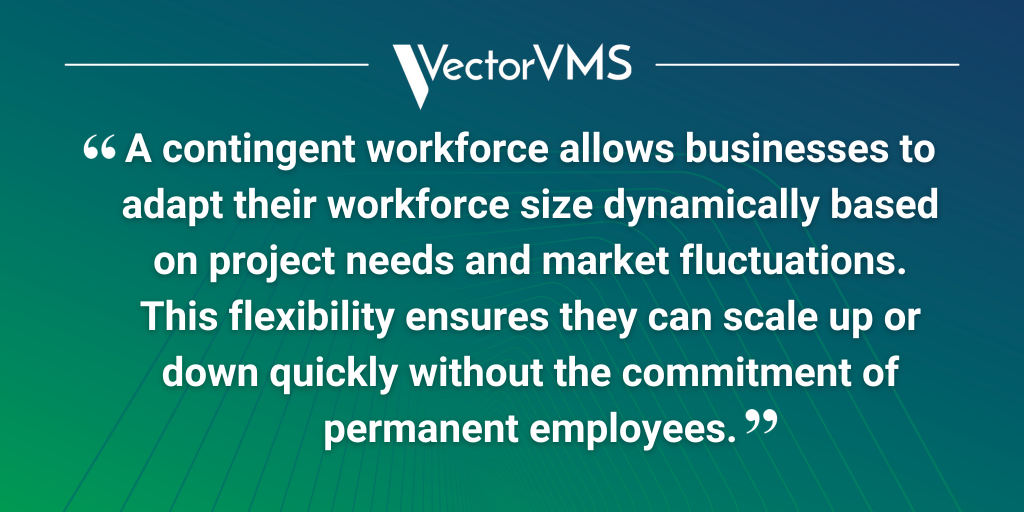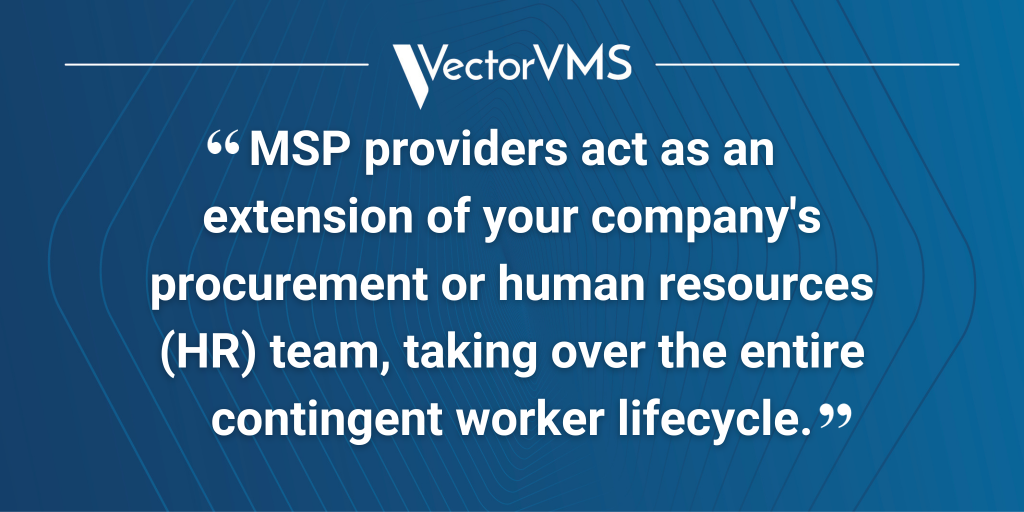You’ve likely heard of the contingent workforce, though perhaps under other names like freelancers, gig workers, and contract workers. Today’s organizations increasingly leverage this flexible talent pool via tools such as vendor management systems (VMSs) to access specialized skills, reduce costs, and adapt to evolving business needs. However, navigating the intricacies of managing a contingent workforce can be challenging without a firm grasp of the key concepts involved.
This guide is here to equip you with the basic knowledge you need to begin your contingent workforce journey.
What Is a Contingent Workforce?
A contingent workforce is a pool of non-employee workers who provide their services to an organization on a temporary, project-based, or on-demand basis. This includes individuals like freelancers, independent contractors, consultants, and temporary workers. These people offer their specialized skills and expertise to the organization without being formally employed, meaning they aren’t on the company payroll and don’t receive the same benefits as permanent employees.
Organizations can engage with a contingent workforce directly or through staffing agencies, consulting firms, or VMSs.
What Types of Contingent Workers Are There?
Some common types of contingent worker include:
- Independent Contractors: Self-employed individuals who provide specialized services to another company, typically on a long-term or full-time basis, and sometimes exclusively for one client.
- Freelancers: Self-employed individuals who offer specialized services, often project-oriented and short-term, serving multiple clients simultaneously. Examples include photographers, video editors, and graphic designers.
- Consultants: Independent professionals with extensive experience and expertise in a specific industry. They’re hired to assess and solve specific problems, develop strategies, and provide qualified advice.
- Temporary Workers: Employed by a staffing agency or other third party and assigned to work for an organization on a temporary basis. They can be part-time, full-time, or seasonal workers, paid hourly or on a salary.
It’s important to note that the terms “independent contractor” and “freelancer” are sometimes used interchangeably, but freelancers primarily seek shorter, more task-oriented projects, while independent contractors tend to pursue longer-term engagements. Additionally, temporary workers are sometimes directly employed by companies, especially for seasonal positions like those in tourist areas experiencing increased staffing needs during the summer.
MORE FROM THE BLOG | ‘The Rise of the Gig Economy: What Is It and Why Should I Care?’

5 Benefits of Having a Contingent Workforce
Leveraging a pool of contingent workers offers significant advantages for organizations, such as:
1) Cost-Effectiveness
Hiring contingent workers often proves more affordable than hiring full-time employees. This translates to cost savings on benefits, payroll taxes, and extensive onboarding procedures. Further, companies only pay contingent workers for the specific skills and duration required.
2) Flexibility and Scalability
A contingent workforce allows businesses to adapt their workforce size dynamically based on project needs and market fluctuations. This flexibility ensures they can scale up or down quickly without the commitment of permanent employees.
3) Access to Unique Skillsets
Contingent workers possess specialized skills, including hard-to-find ones. This provides companies with access to expertise they might lack in their core team, filling crucial gaps for specific tasks.
4) Faster Project Completion
Due to minimal onboarding and training requirements compared to full-time hires, contingent workers can accelerate project completion timelines.
5) Increased Job Security for Core Employees
The flexibility of a contingent workforce can help protect the jobs of permanent employees during fluctuations in workload.
What Is Contingent Workforce Management?
Contingent workforce management encompasses the strategic oversight of non-permanent workers within an organization. It involves the entire lifecycle of managing this labor pool, from recruitment and onboarding to performance monitoring and compliance. The ultimate goal is to access specialized skills, optimize costs, and achieve greater flexibility in scaling the workforce to meet changing business demands.
What Is a Statement of Work (SOW)?
SOWs are legally binding agreements commonly used when engaging different types of contingent workers. They serve as a roadmap for a project between two parties, outlining the project’s scope, including specific tasks, deliverables, deadlines, costs, and any other relevant information. By ensuring clear expectations, SOWs minimize misunderstandings and promote successful project execution.
What Is a Vendor Management System (VMS)?
A VMS is a platform designed to streamline the entire lifecycle of an organization’s contingent workforce. The core functionality of VMS software includes automating and centralizing various processes, from sourcing and engaging workers to managing contracts, timekeeping, invoicing, and reporting. This centralized system provides program managers with a comprehensive view of their contingent workforce, allowing them to optimize cost, efficiency, quality, and risk management.
Implementing a VMS offers these key benefits:
- Improved efficiency: A VMS automates tasks like onboarding, time entry, and approvals, saving administrators time.
- Complete program visibility: VMSs provide a centralized view of the entire contingent workforce program, allowing for better control.
- Vendor consolidation: The platform simplifies vendor management by consolidating information in one location, enabling better vendor selection and relationship management.
- Reduced costs: VMSs help negotiate better rates with vendors, minimize rogue spending, and streamline processes, leading to overall cost savings.
- Enhanced compliance: A VMS centralizes data and creates audit trails, ensuring compliance with regulations.
- Data-driven decision-making: These systems provide centralized reports for analyzing data and making informed decisions about contingent workforce management.
LEARN MORE | ‘11 Questions to Ask Before Buying a VMS’

What Is a Managed Services Program (MSP)?
MSP providers act as an extension of your company’s procurement or human resources (HR) team, taking over the entire contingent worker lifecycle.
A program provider’s responsibilities include finding qualified candidates, coordinating interview processes, overseeing the hiring and onboarding experience, and managing the administrative tasks associated with invoicing, payment processing, and data-driven program analysis. Further, these providers can offer expert guidance regarding compliance with local regulations, encompassing areas such as taxation and worker security.
The key benefits of engaging with an MSP provider include:
- Enhanced visibility and control: Providers will offer a centralized platform to manage your entire non-permanent workforce, ensuring complete transparency into costs, talent pools, and compliance.
- Improved hiring and reduced costs: The MSP approach leverages expertise and access to diverse talent pools to quickly find the ideal candidate. This minimizes time and costs associated with recruitment.
- Better scalability: The MSP model adapts to your business needs. Whether you require seasonal staff or independent contractors for large projects, it can ensure you always have the right resources at your disposal.
- Reduction of risks: Program providers can provide legal counsel to navigate ever-changing employment legislation across different jurisdictions, minimizing potential risks for your business.
- Streamlined processes: Providers will also handle the complexities of contingent workforce management, freeing your internal HR and talent acquisition teams to focus on core strategic initiatives.
What Is Shared Managed Services (SMS)?
SMS is a hybrid program offered by VectorVMS that empowers clients to maintain control and ownership over their contingent workforce program while gaining access to a pool of specialized services and contingent staffing experts.
You have full control over how involved VectorVMS is with your system and processes. Clients can choose from a catalog of services to select the specific tasks and areas where they require expert assistance. This ranges from day-to-day administrative tasks to strategic guidance leveraging the provider’s industry experience and knowledge.
The key benefits of the SMS approach include:
- Internal program control: Leverage internal knowledge of company culture to create a cohesive talent strategy within your contingent workforce program.
- Strategic opportunities: Get the service team to handle operational tasks while providing industry insights and feedback that inform your contingent labor strategy.
- Cost savings: Achieve tangible cost savings through rate rationalization and operational efficiency, reducing the time and money spent on managing contingent labor.
- Vendor neutrality: Ensure true neutrality by eliminating any potential conflicts of interest between service providers and staffing organizations.
- Total talent management: Provide client visibility across the entire workforce, encompassing full-time employees, contractors, and all non-traditional roles.
YOU MIGHT ALSO LIKE | ‘6 Vendor Management System (VMS) Myths Debunked by Experts’
Risks of Contingent Worker Misclassification
In the U.S., the law mandates that companies must accurately classify their workers as employees or independent contractors, with significant penalties for misclassification. This is particularly crucial for contingent workforce management, as the category of “independent contractor” defined by the U.S. Department of Labor encompasses many types of contingent employees described above.
In January 2024, the Department of Labor finalized a rule clarifying worker classification under the Fair Labor Standards Act (FLSA). This update introduced a six-factor “economic reality test” to help businesses accurately classify their workers. Recognizing the importance of proper classification, we’ve created a helpful resource based on these six factors to guide you through assessing your worker situation: View the resource here.
Ready to empower your business with a flexible workforce? Contact us for expert guidance in building your contingent workforce program, or request a demo to discover how our reliable vendor management system streamlines the process!
 Meet the Expert
Meet the Expert
Nikki Williams – Marketing Brand Manager
Nikki Williams is responsible for marketing strategy and implementation for VectorVMS. In her role, she helps contingent workforce professionals discover the value of a vendor management solutions through blogs, webinars, conferences, and more. Her goal is to ensure these professionals can quickly find answers to their questions about VMS technology. Nikki has more than 10 years of experience as a marketing professional for technology, including human resources technologies as well as leadership and organizational development services. Connect with her on LinkedIn.



